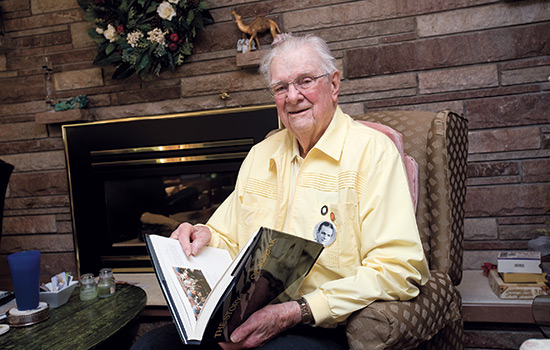War turns lab worker into pilot
A. Sue Weisler
Alva Redfield ’41 (chemistry) was a Navy pilot during World War II in between working at Kodak. He remains active with the Geriatric Pilots Association.
Alva Redfield ’41 (chemistry) started his co-op at Eastman Kodak Co. on his 18th birthday in 1939. He earned 45 cents an hour.
“I thought it was a pretty good deal because I had been working on the farm for 20 cents an hour,” he says. “And there we worked 10-hour days and you didn’t get time off for lunch.”
Redfield had just finished his first year at the Rochester Athenaeum and Mechanics Institute, which is what became RIT, when he began the Kodak job on Aug. 29, 1939. In high school, he studied vocational farming but realized he didn’t want to pursue a career in agriculture. He liked science so when he heard his cousin was applying to the Mechanics Institute, he joined him.
“The two of us came up and tried the entrance exam,” he says. “My math was a little rusty but they thought maybe they could use me.”
Students at that time worked on co-op for four weeks and attended classes for four weeks. Redfield worked in the paper service testing department at Kodak. He was assigned first to the strip alley, drying processed strips of photographic paper. He later was promoted to the darkroom at the back of the strip alley, where he tested outdated photographic paper.
“Back in those days you didn’t get paid an awful lot,” he says. “I lived on 10 dollars a week. Are you going to ask me how I did that? Well, $7 to live at the central YMCA for my room. The rest was for meals. You could get a dinner back then for 35 cents.”
Kodak, he says, must have liked his work because after graduation he landed a full-time job in the pulp-testing laboratory.
Then on Dec. 7, 1941, the Japanese attacked Pearl Harbor. The draft age was 21 and Redfield didn’t turn 21 until the following August, but he wanted to become a Navy pilot. After convincing his mother to sign the papers, he was sworn in on July 10, 1942.
He was on active duty three years during World War II, working mostly as a replacement pilot on escort carriers, and two years during the Korean War, stationed in the Mediterranean.
He remains a lieutenant commander of the U.S. Navy Reserve and is a member of the Geriatric Pilots Association, a group of Rochester-area military and civilian pilots who meet regularly and speak in schools.
In between his military service, Redfield returned to Kodak. He retired in 1982 at the age of 60 so he could travel with his late wife, Beatrice, and spend time with his three children.
Redfield remembers details of his time in the Navy like they were yesterday and enjoys telling stories about his training, service and the many men he met during those days.
He also smiles when he talks about Kodak, his first boss there who was an ex-Marine in World War I, and how much he learned on the job. “The co-op opened the door at Kodak,” he says. “It got me in. Because I was a good worker, I progressed.”















